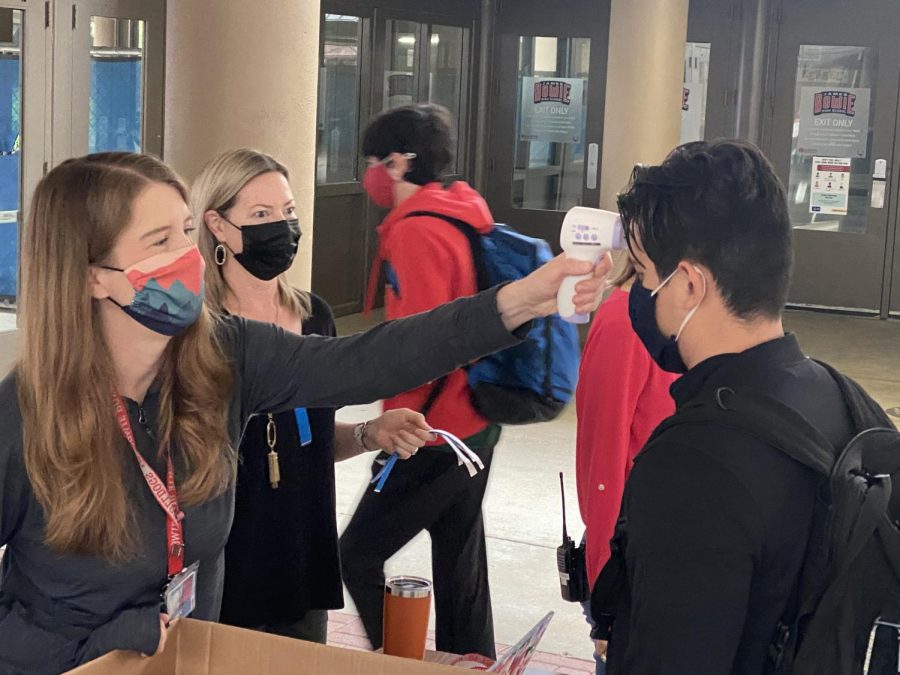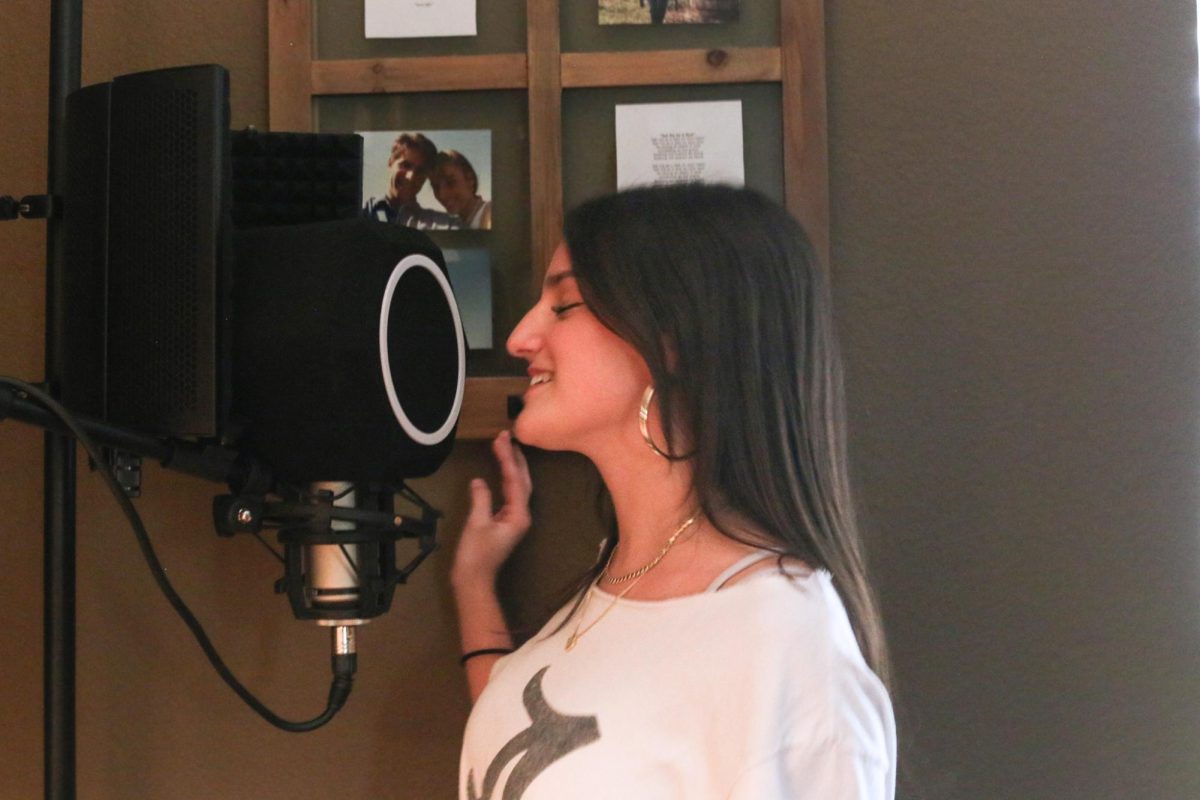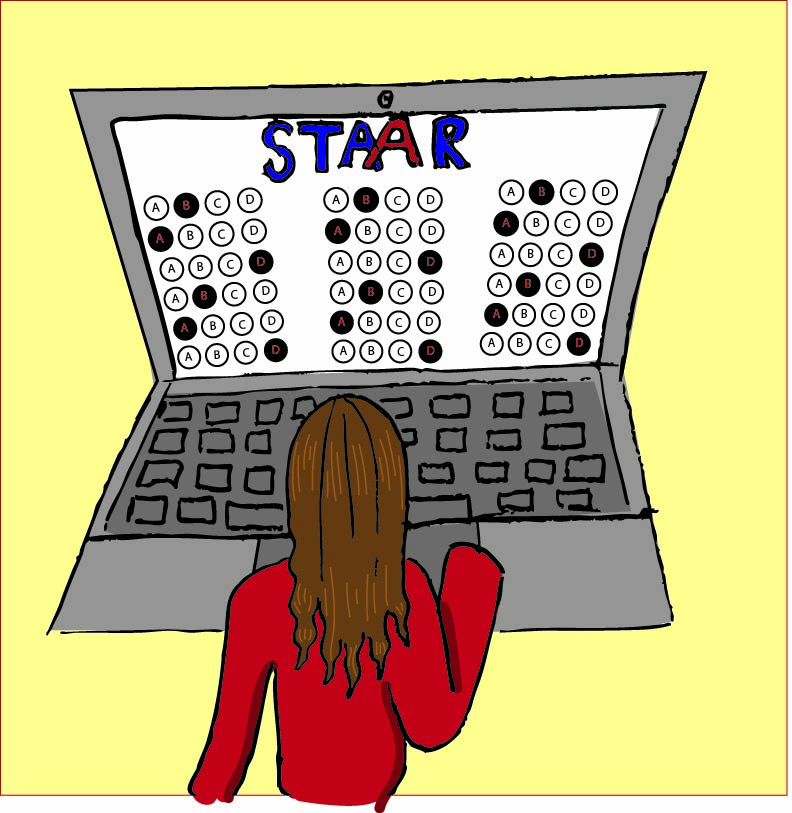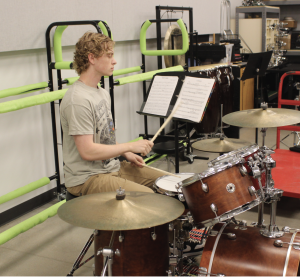COVID-19 relief bill gives aid to Texans
STAYING SAFE: Assistant Principal Marie Prescott administers a temperature check while graduation coach Wendy Escobedo hands out colored wristbands students wear daily. Students who choose to attend school in-person have to complete a screening before they can enter the building. PHOTO COURTESY OF Michael Reeves
May 13, 2021
The $1.9 trillion law includes $1400 stimulus checks and extended unemployment
President Biden signed the American Rescue Plan, marking the third stimulus bill signed into law during the Covid-19 pandemic.
Some of the most notable elements of the bill include $1400 checks for most Americans, extended unemployment benefits, and an expansion of the child tax credit. As of April 1, more than 130 million Americans have received their stimulus checks from the American Rescue Plan, according to the IRS.
“It was a long time coming and it gives our economy what it needs to push through the pandemic and return to a normal life – so I’m a strong supporter,” Bowie parent Ed Scruggs said. “The checks are coming just in time to help us make vital home repairs and payoff bills.”
The eligibility for stimulus checks are dependent on the tax filers income and filing status. Individuals who earn up to $75,000 per year and married couples who file their taxes jointly making up to $150,000 a year are eligible for the full $1,400 checks. Adult dependents are also now eligible for stimulus checks.
“I don’t think [the checks] are necessary for everyone,” junior Austin Dalbey said. “They should be going to the unemployed, and people who have been severely effected by the COVID-19 economic downturn.”
A Gallup poll found that 63 percent of Americans support the American Rescue Plan. According to the poll, 97 percent of Democrats support the bill and 18 percent of Republicans support the bill.
“I support the bill because it helps people who have lost their jobs or not been able to work as much due to the virus,” social studies teacher Charles Stampley said. “It helps families get their kids back in school so they can return to work.”
Along with provisions aimed to help recover the economy, the bill includes money aimed at getting Covid-19 under control. FEMA will receive $50 billion to assist vaccine distribution and an additional $47.8 billion is allocated for testing, contact tracing, and other mitigation strategies.
“The biggest issue with teachers now is vaccine access,” Stampley said. “If more teachers are able to get vaccinated, there will be less concern over safety. Fortunately, AISD and other groups are already working to get more teachers’ shots. If more kids come to school we will definitely need more masks and PPE.”
Although the bill has been signed, questions linger over how some funding from the bill will be allocated. $12.4 billion dollars for reopening schools are allocated to Texas, but there’s uncertainty over how that money will be spent.
“[Austin ISD] hopes that funding will be allocated directly to Districts, who are in the best place to prioritize how to utilize the funding to benefit students and the classroom,” an AISD spokesperson said in a public statement. “While earlier federal funding was utilized to supplant state funding, it appears the last two stimulus funding should go directly to districts.”
Some states, like Pennsylvania, have allocated most of their federal funding for K-12 schools directly to the school districts, and public school advocates are calling on the Texas Education Agency to do the same. School districts that receive federal funding are allowed to spend it in a multitude of ways, including hiring more teachers, improving ventilation systems, and purchasing PPE.
“We are still waiting for the state to provide final guidance and allow districts to start allocating funding,” the AISD spokesperson said. “Once received, we will prioritize student mental, social, and academic supports, especially for our traditionally marginalized students. We also would use funding for improving our safety and ventilation systems in buildings, technology, and summer programming.”
The nearly $2 trillion price tag for the bill has caused concerns about inflation.
“Spending $2 trillion when COVID-19 is starting to go away, and the economy is starting to recover, will end up causing unnecessary national inflation,” Dalbey said.
CDC data shows that nearly 31 percent of Americans have received at least one dose of the vaccine as of April 2. Supporters of the bill believe that the bill will help get Covid-19 significantly under control.
“[The bill] means we will have everything we need to complete vaccinations, expand testing, and conduct contact tracing,” Scruggs said. “Finally, we have everything needed to give the virus a major final knockout blow.”









